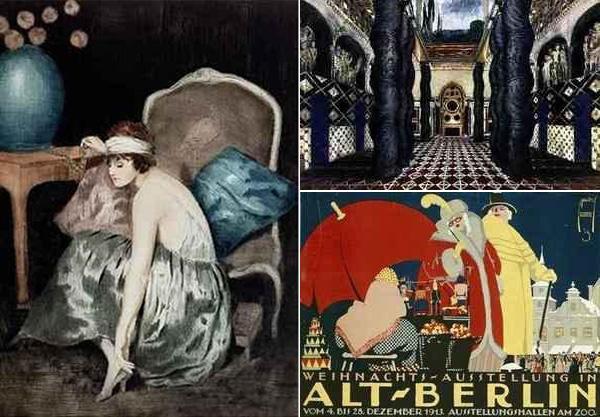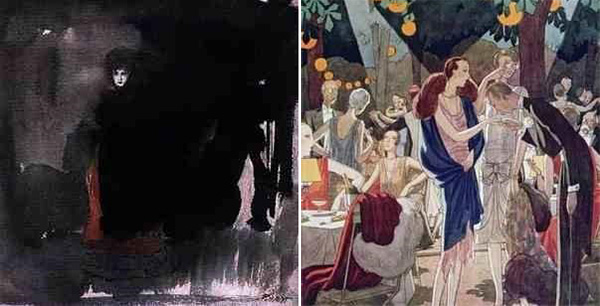Art Deco: Main Features and Influence
November 27, 2019
Art Deco was a style that came to popularity in the early 20th century and reached its peak in the 1920s and 1930s. It was especially common in the United States and Western Europe and there weren't many areas that didn't see the style. From the architecture and interior design of buildings to fashion, Art Deco became overwhelmingly common.
To really appreciate Art Deco paintings and artwork, it's important to take a step back and consider what Art Deco is and where it came from.

What Defines Art Deco?
The Art Deco era was born in Paris and quickly spread to the rest of Europe and over to the United States. The style is defined as a very direct, streamlined, and symmetrical shapes. It also relies heavily on geometrical influence. Practicality is also a key feature but this is often demonstrated in architecture and usable object design.
The style also leans heavily on an expensive appearance. This is why tones such as gold and silver are so common. The themes in paintings often showed extravagant scenes or characters as well.
What Inspired Art Deco?
Art Deco actually draws from a number of previous artistic movements. It's easy to see the influence of genres such as Cubism, Art Nouveau, and Bauhaus. It also tended to draw from further back including the Classical Period as well as Egyptian and Native American influence.
Many paintings also reflect the environment of the time. For instance, the lively parties that graced many canvases demonstrated the effects of the economic prosperity of the 1920s. Social changes at the time were also on full display. A female model reclining nude or exploring a night out in an en vogue flapper dress showed the evolving view of society at the time.
These themes can be summed up under the gathered title of modernism. Art Deco consistently tackled the progress that was being made with modern technology and philosophy, often depicting it in a celebratory light.

The Evolution of Art Deco in the 1930s
Of course, while the 1920s were generally prosperous, the 1930s didn't have the same luck. Instead, this was the decade that started economic downfalls such as the Great Depression in the United States. However, this doesn't mean that Art Deco died out.
Rather, during this period of struggle, certain aspects of Art Deco shined while others fell to the wayside. For instance, the idea of design being practical and the visual aspects of design remained in popularity. However, the luxury associated with the era wasn't as commonly seen.
Art Deco Poster Art
Another interesting facet of Art Deco is that it heavily featured poster art. Rather than just being scenes on canvas, the art of this era also included pieces meant for small-scale display. This is interesting because poster art didn't reach its peak popularity until the late 1800s. This makes Art Deco still a rather revolutionary stage in a style of art that remains highly popular today.
The Use of Geometry in Painting
Upon first impressions, the idea of geometry in art can be taken literally. In other words, highly structured patterns that directly play with lines and shapes. This is definitely one direction that artists, and especially architects, took. In addition, though, this use of geometry can be seen in other subject matter as well.
Portraits, as an example, were popular in this time period. Yet, when you look at these portraits, they don't portray the same photorealism of periods like the Renaissance. Instead, the shapes are more angular and exaggerated. A man might have intensified cheekbones or a woman might be shown as particularly tall and thin. The style drew from the world around it but replicated that interpretation with a unique flair.
Urban Themes
Another interesting theme about the Art Deco period was its distinct urban themes. Many artistic periods put a heavy focus on nature and this was depicted in paintings of landscapes and similar subjects. Alternatively, the Art Deco period put more of a focus on the social aspects of busy cities and nightlife.
Rather than these calm scenes, artists in this period were more likely to deliver visuals of flappers, dinner parties, and other social gatherings. That isn't to say that staples like landscapes didn't exist but they weren't as commonplace as they were in other eras.
Conclusion
Art Deco is one of the most distinct artistic styles and it's nearly limitless. Despite only holding its peak popularity for roughly two decades, its influence is still considered timeless in everything from paintings to poster art and even the buildings and objects people used daily. It's also immediately recognizable for the era it came from and is often called on in the popularity of vintage items and artwork in the modern world nearly a century later.
Click Here For The Most Popular On Sunny Skyz
 His Last Day As A Teacher After 36 Years. They Turned It Into A Memory For Life
His Last Day As A Teacher After 36 Years. They Turned It Into A Memory For Life
 The Funniest Wildlife Photos Of 2025 Are Here — And They’re Hilarious
The Funniest Wildlife Photos Of 2025 Are Here — And They’re Hilarious
 This 30-Year-Old’s Christmas Gift To His Mom Is Going Viral
This 30-Year-Old’s Christmas Gift To His Mom Is Going Viral
 A Couple Invited A Homeless Man In On Christmas — And He Never Left
A Couple Invited A Homeless Man In On Christmas — And He Never Left
 A Koala Hitched A Ride On A Bus In Brisbane
A Koala Hitched A Ride On A Bus In Brisbane
 This 'Stranger Things' Fan's Christmas Tree Has An Upside Down Twist
This 'Stranger Things' Fan's Christmas Tree Has An Upside Down Twist
 He Asked For Help Wrapping A Christmas Present — Then Surprised Her With A Life-Changing Gift
He Asked For Help Wrapping A Christmas Present — Then Surprised Her With A Life-Changing Gift
 This Teacher Found A Simple Way To Make Every Student Feel Loved
This Teacher Found A Simple Way To Make Every Student Feel Loved
 Beaver Casually Drags Branch Through Public Area While People Cheer
Beaver Casually Drags Branch Through Public Area While People Cheer
 90-Year-Old Grandma Gets Her Very First Doll On Christmas — The Tears Say It All
90-Year-Old Grandma Gets Her Very First Doll On Christmas — The Tears Say It All
 Coldplay's Chris Martin Surprises Couple At Wedding
Coldplay's Chris Martin Surprises Couple At Wedding
